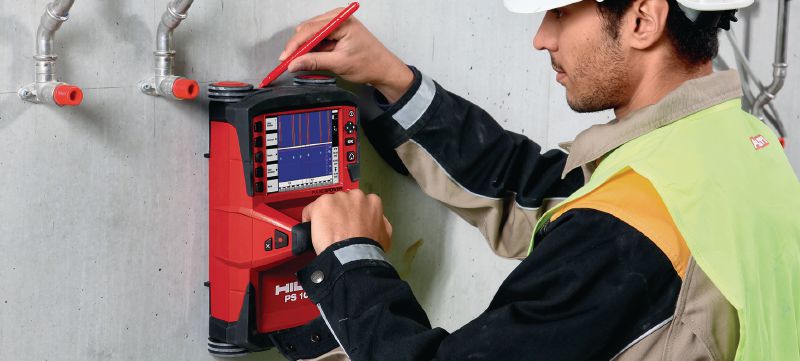Enhance Job Effectiveness with RainierGPR Concrete Scanning Solutions
Enhance Job Effectiveness with RainierGPR Concrete Scanning Solutions
Blog Article
Exploring the Depths: A Comprehensive Overview to Concrete Scanning and Its Diverse Applications
In the realm of construction and infrastructure development, the meticulous procedure of concrete scanning holds a crucial function in making sure the architectural honesty and safety and security of projects. As modern technology remains to progress, the applications of concrete scanning have actually expanded far past plain surface-level assessments. From discovering rebar and post-tension cables to mapping out channels and spaces hidden within concrete frameworks, the capacities of modern scanning strategies are both essential and remarkable. The true deepness of concrete scanning's prospective reaches also further, branching right into unanticipated sectors and triggering cutting-edge services. The interconnected internet of opportunities that concrete scanning presents is not just remarkable but additionally vital for the development of numerous industries.
Significance of Concrete Scanning
Comprehending the relevance of concrete scanning is important in making sure the safety and stability of structures throughout building and renovation jobs. Concrete scanning utilizes sophisticated innovations such as ground-penetrating radar (GPR) and electro-magnetic induction to find embedded items, voids, or other anomalies within concrete frameworks.
Furthermore, concrete scanning plays a crucial function in making certain compliance with building ordinance and regulations that mandate the security of existing structural elements throughout construction tasks. By properly mapping out the interior composition of concrete, scanning innovations enable construction specialists to make informed decisions that maintain the structural stability and resilience of structures and infrastructure jobs. In significance, the importance of concrete scanning depends on its capacity to protect both the structural honesty and the personnel included in building and construction endeavors.
Technologies Utilized in Concrete Scanning
Concrete scanning relies on advanced technologies such as ground-penetrating radar (GPR) and electromagnetic induction to properly spot embedded objects and anomalies within concrete frameworks. Ground-penetrating radar runs by emitting high-frequency electro-magnetic waves into the concrete.
Electromagnetic induction, on the various other hand, works by producing magnetic fields around a concrete structure with a transmitter coil. When metal things exist within the concrete, they interrupt these magnetic fields, causing eddy currents to stream through the metal. By determining the changes in the electromagnetic areas with a receiver coil, the system can identify the location of metallic objects in the concrete.
These cutting-edge innovations play an essential duty in non-destructive screening, guaranteeing the safety and security and honesty of concrete structures in various sectors.
Applications in Building Sector
Within the building sector, concrete scanning innovation discovers varied applications that enhance job effectiveness and security. In addition, concrete scanning is used for finding spaces, such as air pockets or locations of degeneration within concrete, which can compromise the overall toughness of a framework. Concrete scanning plays a vital duty in quality control by validating the density of concrete covers over support, making certain compliance why not find out more with layout requirements and requirements.

Security Benefits of Concrete Scanning
In the world of construction safety, the application of concrete scanning innovation provides a critical benefit in preemptively identifying prospective risks and strengthening architectural honesty. By making use of sophisticated scanning methods such as ground-penetrating radar (GPR) and electromagnetic induction, construction teams can accurately locate rebar, post-tension cable televisions, channels, and various other hidden objects within concrete frameworks. This aggressive approach significantly reduces the risk of unintended strikes during boring, reducing, or coring tasks, thereby avoiding expensive problems, injuries, and job delays.
In addition, concrete scanning boosts employee safety and security by offering real-time info regarding the structural condition of concrete elements. By dealing with potential safety concerns promptly, concrete scanning adds to developing a safe functioning atmosphere and alleviating the probability of structural failures or crashes on building and construction websites.
Future Fads in Concrete Scanning
Arising advancements in scanning innovation are poised to reinvent the field of concrete assessment and analysis. By taking advantage of the power of AI, these systems can assess vast amounts of data accumulated throughout scanning processes to offer even more thorough and precise insights into the condition of concrete frameworks.
An additional significant pattern is the advancement of even more user-friendly and portable scanning devices. Miniaturization of scanning devices enables less complicated access to confined areas and remote places, making examinations more thorough and reliable. In addition, developments in wireless communication modern technologies make it possible for real-time information transfer and evaluation, facilitating quicker decision-making processes.
Moreover, there is a growing concentrate on sustainability in concrete scanning click here to find out more modern technologies - RainierGPR Concrete Scanning. Manufacturers are progressively including environment-friendly products and energy-efficient attributes into their tools to lower environmental effect. These future patterns are readied to improve the efficiency, accuracy, and sustainability of concrete scanning practices, shaping the industry's future landscape
Verdict
In final thought, concrete scanning plays an essential role in the construction industry by making certain the safety and effectiveness Extra resources of numerous tasks. As modern technology developments, the future of concrete scanning holds appealing advancements for enhancing building and construction procedures.

Report this page